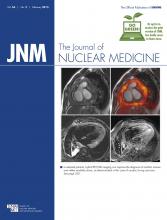Evolution of combined PET/MR: Wehrl and colleagues provide an overview of the effects of concurrent PET/MR acquisition on clinical fields such as neurology, oncology, and cardiology and focus on next steps for full integration into routine practice.
Page 165
Molecular imaging of prostate cancer: Oyen and De Jong offer perspectives on current and novel therapies for prostate cancer and on imaging techniques used to guide, monitor, and aid in optimal selection of such treatments.
Page 169
DOTATOC in meningioma: Marincek and colleagues describe the results of a phase II trial on the long-term benefits and harm of radiolabeled somatostatin-based radiopeptide therapy in patients with unresectable progressive meningioma.
Page 171
Dose–response and 177Lu-DOTATATE therapy: Ilan and colleagues evaluate the relationship between absorbed dose to tumor and response in patients with pancreatic neuroendocrine tumors treated with peptide receptor radionuclide therapy.
Page 177
PET/CT and metastatic neck nodes: Lin and colleagues assess the prognostic capabilities of PET/CT before definitive radiation therapy and chemoradiotherapy in patients with pharyngeal cancers with metastatic neck nodes.
Page 183
Survival and age in DTC: Maier and colleagues discuss surprising results on age and overall survival from a large single-center cohort of patients with differentiated thyroid cancer as compared with statistics from the general population.
Page 190
18F-FDG hot spots in NSCLC: Calais and colleagues identify a quantifiable uptake threshold for tumor subvolumes on staging 18F-FDG PET/CT that may signal greater risk of relapse in patients with non–small cell lung cancer treated with concomitant chemoradiation.
Page 196
PET/CT follow-up in lung cancer: Marcus and colleagues determine the added value of 4 or more follow-up 18F-FDG PET/CT scans in clinical assessment and management after completion of primary treatment in patients with lung cancer.
Page 204
Gleason score and 18F-choline PET/CT: Cimitan and colleagues explore in a large cohort of patients the ability of Gleason scores at diagnosis to predict rates of detection of recurrent prostate cancer with 18F-choline PET/CT.
Page 209
Transformed follicular lymphoma and PET: Wondergem and colleagues compare 18F-FDG and 18F-FLT PET results in patients with follicular and transformed follicular lymphoma in an effort to identify an optimal discriminative tracer for early detection of transformation.
Page 216
NaF PET for treatment monitoring: Hillner and colleagues extend previous research based on results from the National Oncologic PET Registry to look at the impact of sodium fluoride PET performed for treatment monitoring in systemic cancer therapy.
Page 222
AD-like patterns and 18F-FDG: Ishibashi and colleagues assess the levels of fasting plasma glucose that can reduce 18F-FDG uptake in the precuneus in cognitively normal individuals, mimicking patterns seen in Alzheimer disease.
Page 229
11C-PE2I PET in parkinsonian disorders: Appel and colleagues evaluate the ability of 11C-PE2I PET to achieve unambiguous clinical diagnosis in parkinsonian disorders and compare this with the dual-modality approach using 123I-FP-CIT SPECT and 18F-FDG PET.
Page 234
11C-LY2795050 validation: Naganawa and colleagues investigate in healthy individuals the reproducibility of the binding parameters of this new antagonist PET radioligand for the κ opioid receptor.
Page 243
PET/CT dosimetry of 89Zr-cetuximab: Makris and colleagues derive PET/CT-based radiation dosimetry for 89Zr-cetuximab, with special emphasis on determining red marrow–absorbed dose and on implications for uses in immuno-PET.
Page 249
PET/MR and cardiac masses: Nensa and colleagues research the question of whether integrated 18F-FDG PET/MR imaging can improve diagnosis and follow-up in patients with cardiac masses of unknown identity and in patients with cardiac sarcoma after surgical therapy.
Page 255
Motion correction and PET/MR: Fürst and colleagues provide quantitative evaluation of clinical data from different MR- and PET-data–based motion correction strategies for integrated PET/MR imaging and propose a PET-driven gating method for improved respiratory and overall stability.
Page 261
Amyloid and tau tracer binding: Li and colleagues image Alzheimer disease patients and cognitively normal individuals with 18F-THK5117 and 11C-Pittsburgh compound B PET using an image analysis tool to measure distances of tracer-positive voxels from gray matter/white matter boundaries.
Page 270
18F-FDG PET/CT and pediatric malignancies: Uslu and colleagues offer an educational overview of the current literature on 18F-FDG PET/CT for tumor staging in children, summarizing questions that have been resolved and providing perspectives on continuing challenges.
Page 274
SPECT and PET in HNSCC treatment: van Dijk and colleagues describe preclinical visualization of epidermal growth factor receptor with 111In-cetuximab-F(ab′)2 and simultaneous evaluation of tumor metabolism with 18F-FDG PET during combined-modality treatment of head and neck squamous cell carcinoma.
Page 287
Renal protection in PSMA therapy: Kratochwil and colleagues assess in mice the nephroprotective effects of 2-phosphonomethyl-pentanedioic acid on the biodistribution of 2 promising prostate specific membrane antigen ligands for targeted prostate cancer treatment.
Page 293
18F-FDG uptake in infarcted myocardium: Prato and colleagues explore in canines the reliability of 18F-FDG as an accurate indicator of cell-based cardiac inflammation in the early postinfarction period when regional myocardial perfusion is often severely compromised.
Page 299
PET, MS, and microglial activation: Airas and colleagues investigate the use of PET imaging to demonstrate reductions in microglial activation surrounding a chronic focal multiple sclerosis–like lesion under treatment with an established MS therapeutic agent.
Page 305
AD imaging with 18F-PBR06: James and colleagues evaluate the utility of this radiolabeled agent for detecting alterations in translocator protein 18 kDa, a biomarker of microglial activation, in a mouse model of Alzheimer disease.
Page 311
M1 receptor and 123I-iododexetimide binding: Bakker and colleagues detail the binding affinity and selectivity of 123I-iododexetimide for muscarinic acetylcholine receptors, as well as brain distribution in rats and mice, with potential for imaging applications in neuropsychiatric disorders.
Page 317
Naphthalocyanine in optoacoustic imaging: Bézière and Ntziachristos describe a range of basic and translational studies of the optoacoustic responses of a silicon reporter molecule for optoacoustic imaging, including in vivo performance validation.
Page 323
- © 2015 by the Society of Nuclear Medicine and Molecular Imaging, Inc.







